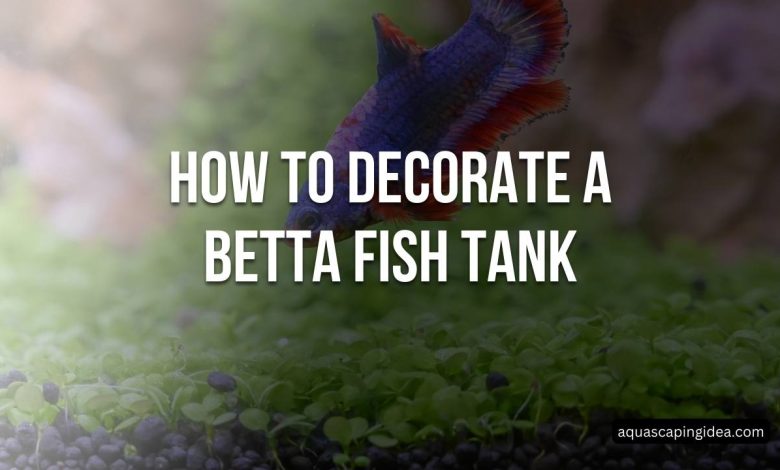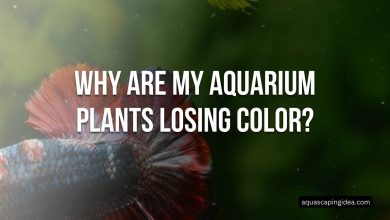
When decorating a betta fish tank, aim for a natural, peaceful environment. Use silk or live plants like anubias and java fern to provide hiding spots and oxygenation. Driftwood, rocks, and caves create territory boundaries and resting areas. Avoid rough decor that could tear fins. Leave open swimming space at the surface where bettas breathe. Use a fine gravel substrate that won’t trap debris. Add tannins from Indian almond leaves or alder cones for a blackwater feel. Maintain good filtration but keep water flow gentle. With thoughtful decor choices, you can create an ideal betta habitat that meets their behavioral needs while showcasing their vibrant colors.
Steps of how to decorate a betta fish tank:
| Step | Action |
|---|---|
| 1 | Choose a suitable tank size (minimum 3.5 gallons for a single betta) and prepare it by cleaning and rinsing thoroughly. |
| 2 | Add a thin layer of fine gravel or sand substrate to the bottom of the tank. |
| 3 | Arrange hardscape items like driftwood, rocks, or terracotta pots to create caves, hiding spots, and visual interest. |
| 4 | Carefully attach or wedge live plants like anubias, java fern, or moss balls to the hardscape using fishing line or aquarium-safe superglue. |
| 5 | Add any other decor items like betta logs, leaf hammocks, or silk plants, ensuring they are smooth and won’t tear fins. |
| 6 | Fill the tank with dechlorinated water, leaving enough space at the top for the betta to breathe air. |
| 7 | Install a sponge filter or hang-on-back filter, adjusting the flow to be gentle and creating minimal surface agitation. |
| 8 | Consider adding Indian almond leaves or alder cones to release tannins and create a blackwater environment. |
| 9 | Allow the tank to cycle and establish beneficial bacteria before adding the betta fish. |
| 10 | Acclimate the betta slowly and introduce it to its new, beautifully decorated home. |
Remember, proper tank size, live plants, hiding spots, and gentle filtration are key for a happy, healthy betta.
Crafting Captivating Betta Aquascapes
While betta fish rightfully capture attention through flowing fins and vibrant colors, thoughtfully decorating tanks to complement these regal specimens creates added interest while supporting health. Strategically furnishing compatible habitats enriches betta quality of life through environmental enrichment. Use these seven design tips for stunning betta showcases.
Match Decor to Betta Temperament
Bettas epitomize beauty, but also carry well-earned fighting reputations through aggressive territorial instincts. Choose tank enhancements minimizing confrontation triggers. Plant thickets, rock caves and driftwood breaks allow dividing territory while reducing line-of-sight confrontations. Target softer circular decor instead of rigid structures with reflective surfaces or mesh potentially snagging delicate fins.
Create a Naturalistic Theme
In the wild, bettas inhabit lush Asian rice paddies bustling with insect life. Replicating this biotope through naturalistic aquascaping encourages natural behaviors while adding intriguing aesthetic Interest. Plant floating pennywort, anacharis, water wisteria and java fern to mimic native vegetation, integrating botanical elements like driftwood, smooth stones and leaf litter completing authentic flourishes. Use subdued lighting with tints of green and yellow hues.
Offer Enriching Hideaways
While exceptionally curious fish, bettas still appreciate shaded, sheltered spots for retreating, especially within exposed sparse bowls. Floating betta logs, coconut shells and quality resin caves satisfy this security while boosting enrichment through investigative exploration opportunities. Just ensure hideaways stay secured from crushing your betta through appropriate sizes and weigh-down techniques for heavy decor items prone to toppling.
Incorporate Stimulating Bubble Features
The incorporation of gentle bubbling water features like air stones, bubble walls and looping bubble disks carries multiple tank benefits. The added surface agitation increases dissolved oxygen levels while creating a gentle ambient backdrop. Bettas frequently play and investigate animate bubbles, deriving cognitive enrichment from these dynamic sights and textures when incorporated responsibly.
Strategically Utilize Live Plants
Thriving live aquarium plants nurture betta health through their roles in filtration and oxygenation while beautifying tanks, but specific selections prove vital. Sturdy Anubias and Java varieties root within hardscape crevices instead of substrates, avoiding diggers uprooting more delicate stems. Floating plants like dwarf lettuce absorb excess nutrients while producing inflorescences for bubble nest building and insectimitative interaction opportunities.
Establish Appealing Color Contrasts
While popular blue and red betta varieties hold seemingly universal aesthetic appeal, creatively utilizing decor to establish contrasting colors markedly intensifies drama. For bright red bettas, emerald green plants and darkened substrates make colors pop. Royal blue specimens display elegantly against neutral tan rocks or yellowish botanicals. Experiment with creative contrasts rather than just matching colors.
Promote Environmental Upkeep
Even the most thoughtfully decorated betta aquascapes lose appeal without disciplined tank maintenance. Keep tanks consistently clean through partial weekly water changes, carefully wiping algae before proliferation and promptly removing decaying plant matter or food debris. Maintain filtration system health supporting water quality. Clip back overgrown stem plants shading lower sections. The impact creative aquascapes make partially depends on how well their beauty stays consistently showcased through responsible upkeep.
By thoughtfully integrating compatible decorative enhancements complementing natural betta beauty while promoting enrichment and environmental welfare, aquarists transform simple betta fish bowls into captivating, dynamic showcases encouraging both human and aquatic admiration! Table: Betta Tank Décor Benefits
| Decor Type | Benefits Provided |
|---|---|
| Driftwood | Shelter, tannins |
| Aquarium plants | Oxygenation, enrichment |
| Resin caves | Shade, exploration |
| Gentle bubblers | Activity, agitation |
| Natural stones | Texture, weights |
Conclusion
Rather than secondary considerations, thoughtfully selected aquascaping elements play pivotal roles enriching betta health through environmental amenities while also showcasing innate beauty. Strategically decorating betta tanks to balance naturalistic flourishes, territorial considerations and accessory variety nurtures vigor while allowing personalities to shine. A bit of creativity, responsibly executed, helps transform basic betta bowls into captivating living artworks!
Frequently Asked Questions
What types of substrate can I use for betta tanks?
Gravel or sand under 1mm diameter works well. Bare-bottomed is fine too. Avoid sharp flakes or particulates staining water or harming bettas.
Are tankmates okay with male betta fish?
Male bettas generally tolerate snails, shrimp or bottom-feeders like Corydoras catfish better than brightly colored smaller fish triggering aggression. Introduce tankmates cautiously.
How many hiding spots should my betta tank have?
Offer 2-3 shaded hiding areas per male betta fish depending on tank size to prevent excessive territorial disputes. Dense plants act as hides too.
Should I get floating or planted aquarium plants?
Use versatile floating plants while also incorporating easy-to-maintain java ferns, Anubias secured to decor and mosses ideal for low-light betta setups to help purify water.
Can I decorate tanks with plastic accessories?
Yes, as long as plastic plants and ornaments feature smooth, non-hazardous edges. Ensure decorations include no small removable parts or dangling elements capable of entangling delicate fins. Rinse all items thoroughly before adding to tanks.




